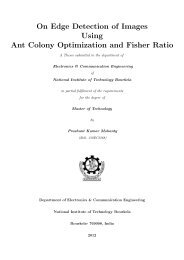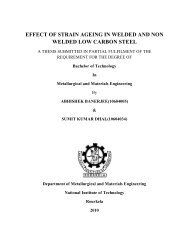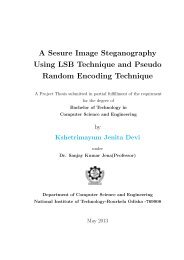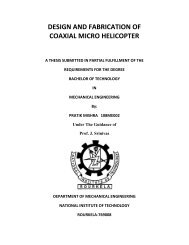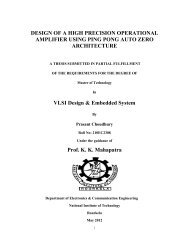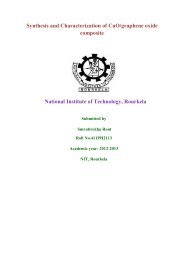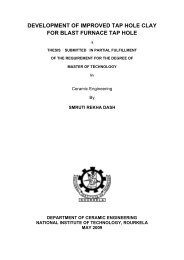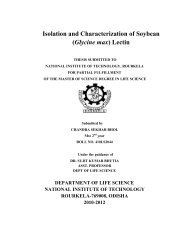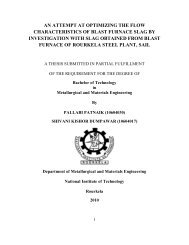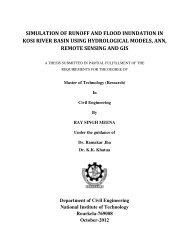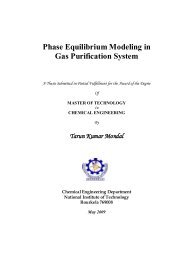Effect of hygrothermal treatment on the tensile properties - ethesis ...
Effect of hygrothermal treatment on the tensile properties - ethesis ...
Effect of hygrothermal treatment on the tensile properties - ethesis ...
Create successful ePaper yourself
Turn your PDF publications into a flip-book with our unique Google optimized e-Paper software.
underg<strong>on</strong>e complete curing and all <strong>the</strong> sites for cross-linking must have participated in<br />
<strong>the</strong> reacti<strong>on</strong> leaving behind no empty sites for additi<strong>on</strong>al polymerizati<strong>on</strong>. The<br />
exposure to 60 0 C would have no effect <strong>the</strong>n. The matrix may have become stiffer due<br />
to loss <str<strong>on</strong>g>of</str<strong>on</strong>g> toughness.<br />
The o<strong>the</strong>r explanati<strong>on</strong> for <strong>the</strong> increase in <strong>the</strong> strength values for short<br />
<str<strong>on</strong>g>hygro<strong>the</strong>rmal</str<strong>on</strong>g> exposure may be due to relieve <str<strong>on</strong>g>of</str<strong>on</strong>g> curing stresses in <strong>the</strong> matrix.<br />
Adsorpti<strong>on</strong> <str<strong>on</strong>g>of</str<strong>on</strong>g> moisture by <strong>the</strong> fibre and matrix comp<strong>on</strong>ents in <strong>the</strong> matrix would cause<br />
swelling stresses to develop, which are <str<strong>on</strong>g>of</str<strong>on</strong>g> opposite nature to that <str<strong>on</strong>g>of</str<strong>on</strong>g> curing stresses.<br />
The moisture absorbed as water molecules may indulge in hydrogen b<strong>on</strong>ding with <strong>the</strong><br />
fibre as well as <strong>the</strong> matrix. This may enhance <strong>the</strong> strength by fur<strong>the</strong>r polymerizati<strong>on</strong>.<br />
Increase in exposure time leads to low strength values. The adsorbed<br />
moisture interacts chemically with <strong>the</strong> matrix. The first water molecules are adsorbed<br />
directly into <strong>the</strong> hydrophilic groups at <strong>the</strong> fibre and after that <strong>the</strong> o<strong>the</strong>r water<br />
molecules are attracted ei<strong>the</strong>r o<strong>the</strong>r hydrophilic groups or <strong>the</strong>y may form fur<strong>the</strong>r<br />
layers <strong>on</strong> top <str<strong>on</strong>g>of</str<strong>on</strong>g> <strong>the</strong> water molecules already adsorbed. This leads to poor adhesi<strong>on</strong><br />
with <strong>the</strong> resin matrix, ultimately causing deb<strong>on</strong>ding. The fracture depends <strong>on</strong> <strong>the</strong><br />
strength <str<strong>on</strong>g>of</str<strong>on</strong>g> <strong>the</strong> fibre-matrix interface. Also it depends <strong>on</strong> <strong>the</strong> toughness and strength <str<strong>on</strong>g>of</str<strong>on</strong>g><br />
<strong>the</strong> matrix. The reduced values <str<strong>on</strong>g>of</str<strong>on</strong>g> displacement at break and energy at yield point may<br />
be due to plasticizati<strong>on</strong> <str<strong>on</strong>g>of</str<strong>on</strong>g> matrix because <str<strong>on</strong>g>of</str<strong>on</strong>g> moisture uptake. This helps in <strong>the</strong><br />
propagati<strong>on</strong> <str<strong>on</strong>g>of</str<strong>on</strong>g> fracture and accounts for <strong>the</strong> low strength values.<br />
The fracture as observed in <strong>the</strong> composite samples can be classified into <strong>the</strong><br />
following types:-<br />
(i) By fibre pullout <strong>on</strong>ly<br />
(ii) By fibre pullout and tearing <str<strong>on</strong>g>of</str<strong>on</strong>g> <strong>the</strong> fibres due to adhesi<strong>on</strong> mechanisms<br />
induced by reacti<strong>on</strong>s at <strong>the</strong> fibre-matrix interface.<br />
(iii) By tearing <str<strong>on</strong>g>of</str<strong>on</strong>g> <strong>the</strong> fibres <strong>on</strong>ly when <strong>the</strong>re is no pullout as <strong>the</strong> fibres are<br />
completely impregnated by <strong>the</strong> matrix<br />
(iv) By shear yielding <str<strong>on</strong>g>of</str<strong>on</strong>g> matrix and tearing from <strong>the</strong> fibre.<br />
30





